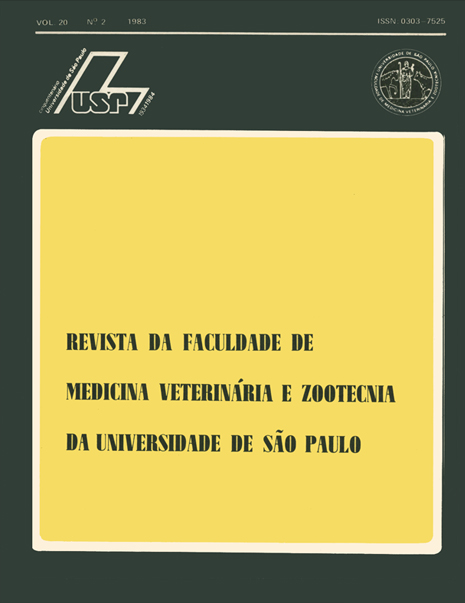Contribution to the study on the innervation of the diaphragm in throughbred horses
DOI:
https://doi.org/10.11606/issn.2318-3659.v20i2p143-153Keywords:
Anatomy of horse, Diaphragm, Phrenic nerveAbstract
The results obtained through the study of 30 diaphragms of adult throughbred horses, extracted from 15 male and 15 female animals from the Jockey Clube de São Paulo and the Jockey Clube Brasileiro, allowed us to come to the following conclusions: 1) The phrenic nerves terminate in a ventral branch and in a dorsolateral trunk on the right (96.7%) and on the left (26.7%), or in a dorsal branch and a ventrolateral trunk on the left (66.7%) and on the right (3.3%). Trifurcations in ventral, lateral and dorsal branches are also found on the left (6,6%). Right and left phrenic nerves are simetrically arranged in a ventral branch and a dorsolateral trunk (26.7%) and a dorsal branch and a ventrolateral trunk (3.3%). 2) The dorsal branches of the phrenic nerves innervate the lumbar portion on the left (86.6%) and on the right (83.3%) respectively. They provide fillets to the tendinous center of the diaphragm either on the right or on the left (6.6%). They also provide fillets to the dorsal leaflet on the right (6.6%), and to the vena cava caudal on the left (6.6%), and only in one case they provide branches to the right lumbar portion (3.3%). 3) The lateral branches of the phrenic innervate the costal portion on the left (90.0%) and on the right (56.6%), more precisely the dorsal and lateral portion. They provide fillets to the dorsal leaflet on the right (20.0%) and on the left (3.3%), they go towards the ventral portion of the costal part on the left (6.6%). 4) The ventral branches of the phrenic nerves innervate the ventral portion of the costal part and the sternal part on the left (86.6%) and on the right (76.6%), respectively. They send branches to the ventral leaflet on the right and on the left (6.6%). They transverse the ventral leaflet which is responsable for the innervation of the heteronomous sternal part on the left (3.3%). They innervate only the ventral portion of the costal part on the right (3.3%). They form a small trunk which extends into two fillets, one to the ventral portion of the costal part, and other to the sternal part of the right (3.3%). They also send branches to the dorsal leaflet of the right (3.3%). They send fillets to the wall of vena cava caudal on the right (3.3%). They send a branch which goes to the tendinous center of the diaphragm on the right (3 3%). 5) The homolateral conexions ("anastomosis") were found on the right (40.0%) and on the left (3.3%) among the following fillets* of the right dorsal and lateral branches (30.0%) the right lateral branch (33%), of the right ventral branch (3.3%), and of the left lateral and dorsal branches (3.3%). 6) The statistical analysis does not show a significant difference, at the level of 5.0%, concerning several aspects of innervation o f the diaphragmatic muscles, when both sexes are compared.


